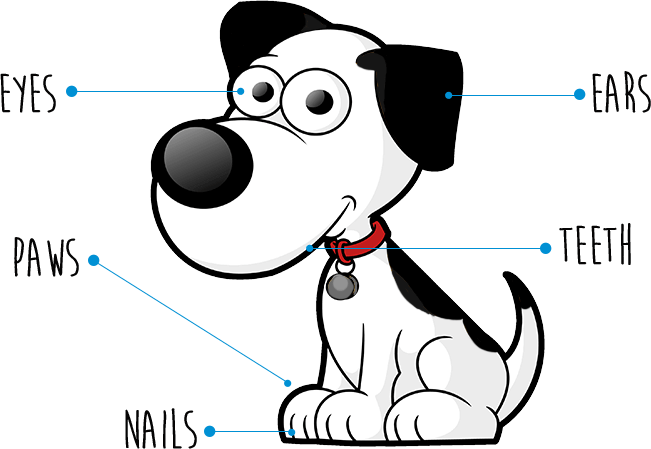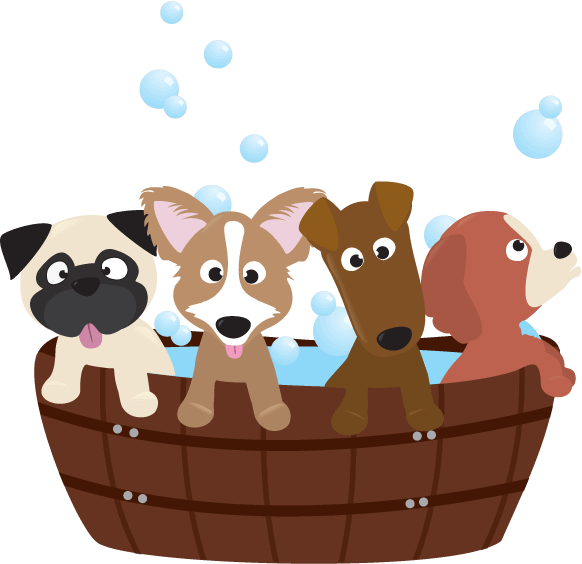

If you have a dog, or are thinking of welcoming a pet dog into your life, it’s important that you know about grooming and bathing care. Bathing and grooming your dog will not only keep them clean and healthy, but you and your home as well.
From training your dog so they learn to enjoy bath time to grooming different areas of your pet’s body, you’ll find everything you need to know in this handy guide. So let’s get started!

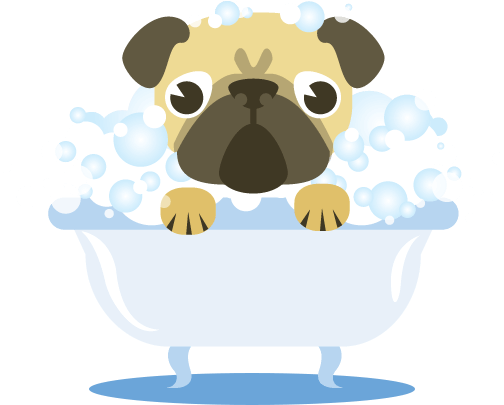
Bathing your dog when needed is an important part of general pet care. For dogs with healthy skin and a healthy coat, the most common reason to bathe is to remove an unpleasant odour or because they’ve accumulated dirt on their coat.
The benefits of bathing can include cleaning the skin and coat which helps to remove loose hair, scale and debris and improve the hair coat’s shine.
For dogs with specific skin conditions, bathing may be part of their medical treatment plan as recommended by their vet.
How often to bathe your dog will vary between each individual dog and their particular needs. Essentially, dogs should only be bathed when necessary.
Bathing is generally required when a dog has an unpleasant odour** or they’ve accumulated dirt/mud on their coat.
So if your dog smells normal (remembering that most dogs have a healthy dog smell which is not unpleasant) and they are not dirty, then bathing is probably not necessary at that stage.
If dogs are bathed too frequently this can dry out their skin and hair coat and may cause problems. Only bathing when it is necessary should help to prevent the skin drying out due to excessive bathing as the natural oils on the skin and coat won’t be stripped away too frequently.
Dogs with skin problems may require different bathing schedules as part of their treatment plan and your local vet can provide advice.
Other dogs who go swimming may require less bathing as this activity can function like a bath. Remember, if you do allow your dog to swim occasionally, supervise them at all times and stick to safe and shallow waters where your dog can always touch the ground.
** If you notice an unpleasant odour from your dog, this could be caused by rolling in something that smells unpleasant, however, if you can’t identify an external cause your dog should be checked by a vet to rule out any medical causes of an unpleasant smell such as skin or ear problems.

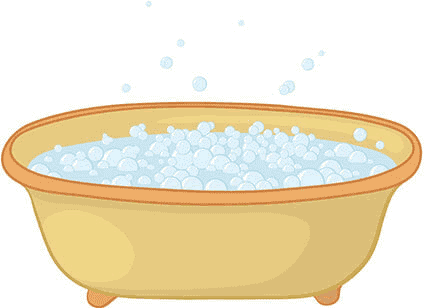
Your local veterinary clinic can provide advice about the most suitable products for your pet dog. Choose a shampoo specifically designed for dogs. Dogs have sensitive skin and their skin pH is different to the pH of human skin so human shampoo products should not be used on dogs.
For dogs with healthy skin and coat, choose a mild and gentle hypoallergenic shampoo. For dogs with skin conditions your local vet can advise what type of shampoo or product to use to help manage or treat specific skin problems.
You can also try applying a mild and gentle hypoallergenic rinse-out conditioner after shampooing to help prevent dryness after shampooing.
Test patch a small amount of products first to make sure there is no reaction or irritation. If your dog seems irritated at all – talk to your vet and try a different product that doesn’t cause any irritation.
Where to bathe your dog tends to vary depending on individual circumstances.
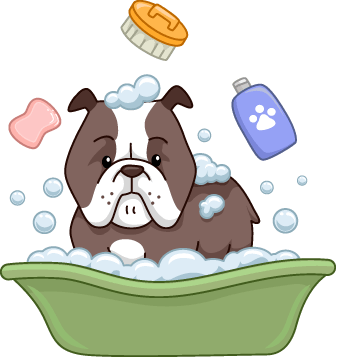
Outdoors
Bath tub/dog tub
Professional bathing services
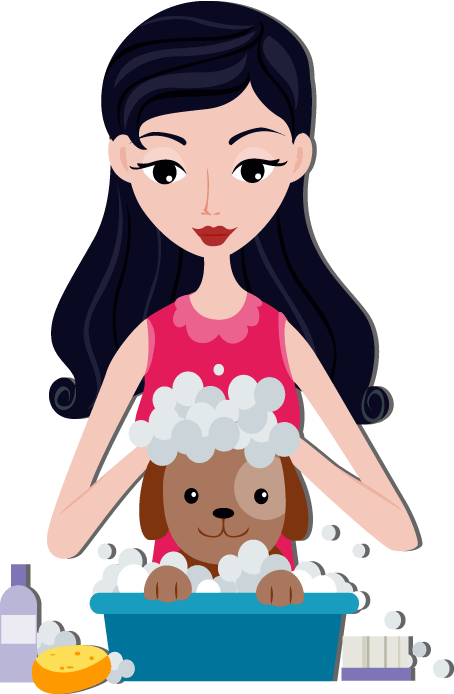

Teach your puppy or dog to be comfortable with handling in general, by patting and stroking different parts of their body. Praise and reward them for being calm and allowing you to handle them. Go slowly, patting them on the chest area, shoulders, sides and along the back, gradually working towards other areas such as each leg. Once they’re comfortable with this, try briefly lifting up a paw, one at a time. Overtime you can extend this to gently touching the footpads and nails and also other areas such as the ear flaps.
Continue to praise and reward (e.g. with tasty dog food treats) for calm behaviour and when your dog allows general handling. This will make your dog less likely to react when you touch them in these areas while bathing.

When introducing your dog to bathing, do it slowly and give them plenty of praise and tasty dog food treats for being calm and tolerating the process. This will help your dog to associate bathing with positive things, helping to make the experience pleasant for your dog and easier for you. You should be calm and speak to them in a positive tone. This will help your dog to be more relaxed. After bath time also be sure to reward your dog with a tasty dog treat so the activity finishes on a good note.
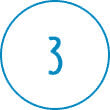
Start by introducing your dog to the bath equipment you’re going to use, one item at a time such as towels, buckets, shampoo containers and hoses. Practise standing on the non-slip mats and reward your dog for standing on the mat. You can also practice standing in the tub but without using any water, this way your dog can gradually get used to being in the tub. Reward with treats while in the tub.
You can also turn on the hose and tap (on low flow) when your dog is nearby so that they can see and hear the running water. Being introduced to bath-related things gradually in a positive and calm way is the best way to train your dog.

Before bath time, you can try going for a nice walk and then, after having a rest when arriving back home, you can try bath time. This way your dog will probably be a bit tired having expended some energy and therefore they’ll be less likely to be energetic during bath time.
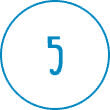
Now that your dog has been positively introduced to bath equipment and the tub (if you’re using a tub) you can introduce them to having a bath. Remember to be patient, if your dog gets upset, stop and try on another day.
If your dog joined the family at an older age, the same steps apply: approach bathing in a gradual, calm and patient manner, and give your dog lots of praise and rewards along the way, making each and every bathing experience a positive one.

If your dog has any mats or tangles it may be a good idea to give them a nice brush and trim off mats/knots before bath time.
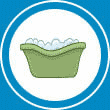
Wet your dog’s hair all the way to the skin working from the chest/neck area down the back and sides of your dog towards the tail. If you’re using a tub let the water run down the drain so it doesn’t fill up.
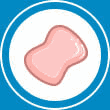
Avoid wetting the head area as dogs are very sensitive there. Take care to avoid the eyes, ears, nose and mouth areas. For many dogs, the general head area is better cleaned by gently using a damp face cloth.

It’s important to prevent water getting into the ears as this can predispose towards an ear infection.
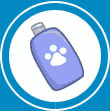
Once the body is thoroughly wet, apply some hypoallergenic dog shampoo (having previously applied a test patch to your dog to ensure there’s no irritation). Start at the chest first before gradually moving out to other areas of the body, making sure you get right down to the undercoat.
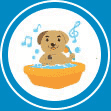
After the chest area, gently massage the shampoo onto the shoulder area, down your dog’s sides, back, front legs, back legs and tail area. Once they’re comfortable you can quickly wash their underside (note this area can be ticklish and sensitive for some dogs).

After shampooing your dog, gently rinse out the shampoo thoroughly using your fingers to ensure that you get through the undercoat.
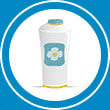
Next, you can apply a gentle hypoallergenic dog conditioner, repeating what you did when shampooing your dog. Depending on the type of conditioner you’re using, you may have to let it sit on the coat for several minutes before rinsing it out thoroughly.

Now that your dog’s bathed you’ll need to help dry them off (see ‘Drying your dog’ below).

Remember to offer some tasty dog food treats to reward for calm behaviour and for staying with you, when you can throughout the activity. Also reward at the beginning and the end. When bathing has finished other rewards may include new chew toys or playing a favourite game. This will help your dog learn to love bath time making the experience fun and enjoyable for the both of you.

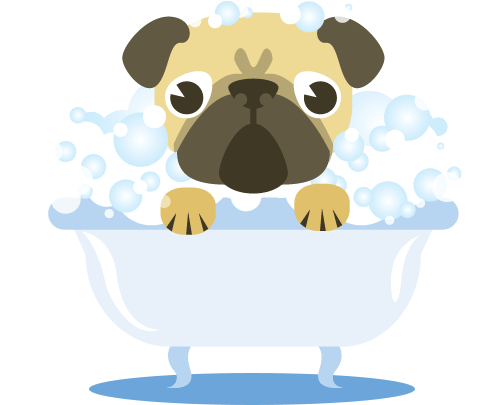
While dogs will tend to instinctively shake off excess water after getting wet, you will probably also need to help them dry off with some large absorbent towels. After this, most dogs can be allowed to air dry naturally.
Avoid using hair dryers as most dogs don’t like air blowing at them and they can also get too hot.
If hair dryers are unavoidable, always take all safety precautions. Directly supervise the dog at all times, avoid the head area and ensure the air is always at a comfortable temperature (not too warm or hot). The dryer should also be placed a good distance away from the dog.
Preparing for the bath is the next step to take. Whether you’re bathing your dog indoors or outdoors, you should move all your bathing equipment to the desired location in a clean, safe, and reachable area. While you’re organising everything, do so quietly and calmly so as to not alarm your dog.
If you’re using the bathroom, put the shampoo and conditioner to the side where your free hand will be (your other hand will be holding onto your dog). Place the towel on a towel rack, away from the water, and put the treats in your pocket so you can easily get them out when needed. Other tools and equipment should be within reach of your free hand, but safe from the water. And don’t forget to place the bath non-slip mat in the tub, as well as one next to the tub, to prevent you and your dog from slipping and causing injury.
Now it’s time to get your dog!
Use tasty food treats and an encouraging voice to call them to the bathroom or out into the yard. Plenty of prior introduction to bath-related things in appositive way will make things easier (see ‘Training your dog to enjoy bath time’ above).

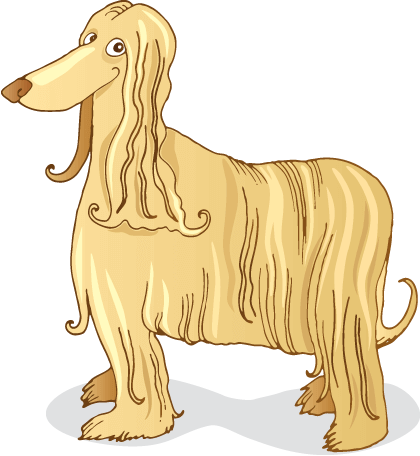
Brushing and combing your dog’s hair coat is an important part of general pet care. Brushing helps to keep your dog’s coat in good condition by removing loose hair and preventing hair mats/knots. Brushing also helps to distribute healthy natural skin oils over the hair shaft, promoting a shiny coat and helping dirt to slide off the hair. This can also help to reduce the need to bath and therefore reduce the frequency of bathing.
Brushing and grooming are activities that help to strengthen the positive relationship bond between dogs and their owners. Brushing should be a pleasant and comfortable experience for dogs and owners.
How often to brush and groom your dog will depend on each individual dog. Dogs tend to differ in their need for brushing because of their coat type and length and also depending on their recent activities.
Dogs with short coats generally require less brushing and grooming compared to dogs with medium to long haired coats as these longer coats can get tangles, mats and debris trapped in them more easily.
Some very short-haired dogs may not need traditional ‘brushing’ and for these dogs, owners may instead like to try a soft grooming glove to gently remove loose hair, occasionally.
Dogs should be brushed ‘as required’. Owners should monitor the condition of their dog’s coat, looking for any tangles/mats or dullness which indicates they might need a brush. Grooming can take anything from a few minutes to several hours a week depending on your type of dog.
As a general guide:
Not grooming your dog as often as required can have an influence on their health. Mats and knots can worsen and moisture that is trapped underneath a matted coat and lack of airflow can predispose towards skin irritation and infection. Grooming is therefore a preventative activity.
If your dog has a lot of matting, you may need to take them to your local vet who can safely remove the tight mats as they can be difficult to remove without specialised clippers. Your vet can also examine the condition of the skin underneath and advise if any medications are needed.

Teach your puppy or dog to be comfortable with handling in general, by patting and stroking different parts of their body. Praise and reward them for being calm and allowing you to handle them.
Go slowly, patting them on the chest area, shoulders, sides and along the back, gradually working towards other areas such as each leg. Once they’re comfortable with this, try briefly lifting a paw up, one at a time. Overtime you can extend this to gently touching the footpads and nails and also other areas such as the ear flaps and under the chin area.
Continue to praise and reward (e.g. with tasty dog food treats) for calm behaviour and when they allow general handling. This will make your dog less likely to react when you touch them in these areas while grooming.

Once they’re used to general handling on different parts of their body, you can slowly introduce them to a brush. Associate the ‘brush’ with positive things (tasty dog treats) and use reward-based training. For example, if your dog remains calm and happy when patting them and having the brush next to them (without brushing yet), then reward with dog food treats. This way your dog will associate ‘the brush’ with something pleasant and this will help to facilitate the process.

Once your dog is used to having the brush next to them and when your dog is relaxed, try brushing very lightly and gently with just a few strokes on the chest area. If they allow this and are calm then reward with some tasty treats. Overtime you can gradually increase the number of brush strokes and the length of time you brush your dog and extend brushing to other parts of their body. Brush in the direction of the hair growth.

Once your dog is comfortable with brush strokes in the direction of the hair growth you can do the occasional brush stroke in the direction opposite hair growth. This will allow you to do a quick check of the skin and look out for any fleas/flea dirt etc.
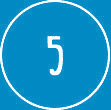
Make sure the brushing experience is always comfortable and soothing for your dog. If there are mats, knots or tangles you may need to have these carefully trimmed off rather than brushed to avoid any jerking movements or pulling which may cause pain and discomfort.

If your dog gets upset or seems uncomfortable, stop brushing and resume on another day starting on a body area that your dog is comfortable with, and then continue to reward for calm behaviour and gradually build up from there.

Observe your dog’s reactions to brushing and if your dog seems uncomfortable you should check the type of brush you’re using to make sure it is soft enough and not causing any physical discomfort. Also reduce the pressure being applied (try lighter brushing). Be aware that brushing might also tickle in some spots which could cause your dog to move, so you should try different brushing techniques until your dog is comfortable. Your local veterinary clinic can advise you about suitable brushes and combs.

It’s best to keep grooming sessions short so your pet doesn’t get overwhelmed (unless your dog really enjoys the process). Remember to praise your dog and give them tasty dog treats throughout the grooming session and when finished to end on a good note. This will positively reinforce the activity and help to make it a pleasant experience.

In addition to brushing, some dogs may need their hair trimmed from time to time. Your local veterinary clinic can advise and show you how to trim your dog’s hair safely or you may like to organise for the vet clinic or professional groomer to assist. Some professional groomers will work from a vet clinic.
Common body areas that may require regular hair trimming for some dogs include:
Safety tips:
Never point scissors towards the dog, extra care must be taken if trimming any hair around the eyes to avoid contacting the eyes.
Use food treats to reward for calm behaviour so your dog associates hair trimming with positive things and rewards.
Moreover, different types of dogs can require different brushes. It’s important to use a brush that is comfortable and suitable for your dog. Make sure the brush does not cause any physical discomfort to your dog.
Brushing should be a pleasant, soothing and relaxing activity for your dog. Talk to your local vet clinic and professional groomer for advice. Always watch your dog’s reactions. Change brush types and decrease the pressure applied if your dog seems at all uncomfortable.
Short-haired smooth coated dogs may suit a soft grooming glove or soft brush to remove loose hair. Dogs with medium to long-hair coats may require combs and brushes with longer bristles/projections (please make sure the bristles don’t cause any discomfort).
For more specific information on caring for your dog’s paws, nails, ears, teeth, and eyes, read on below.
You can keep your dog’s paws healthy by:
Follow these steps to best trim your dog’s nails:
Note: Adequate daily exercise should help to keep nails in good condition and at a good length as nails are naturally worn down. However, nails which don’t touch the ground surface such as the ‘thumb’ nails higher up on the feet, may need to be trimmed occasionally to prevent them from getting too long, curling over and digging into the skin.
Here are some tips for ensuring your dog’s ears are healthy:
It’s helpful to know the signs of an ear problem. These can include head shaking, ear discharge, ear scratching, rubbing ears along the floor or furniture, redness/swelling around the ear opening; sensitivity around the head area; a head tilt and an unpleasant odour.
To help keep dog’s teeth and gums healthy:
